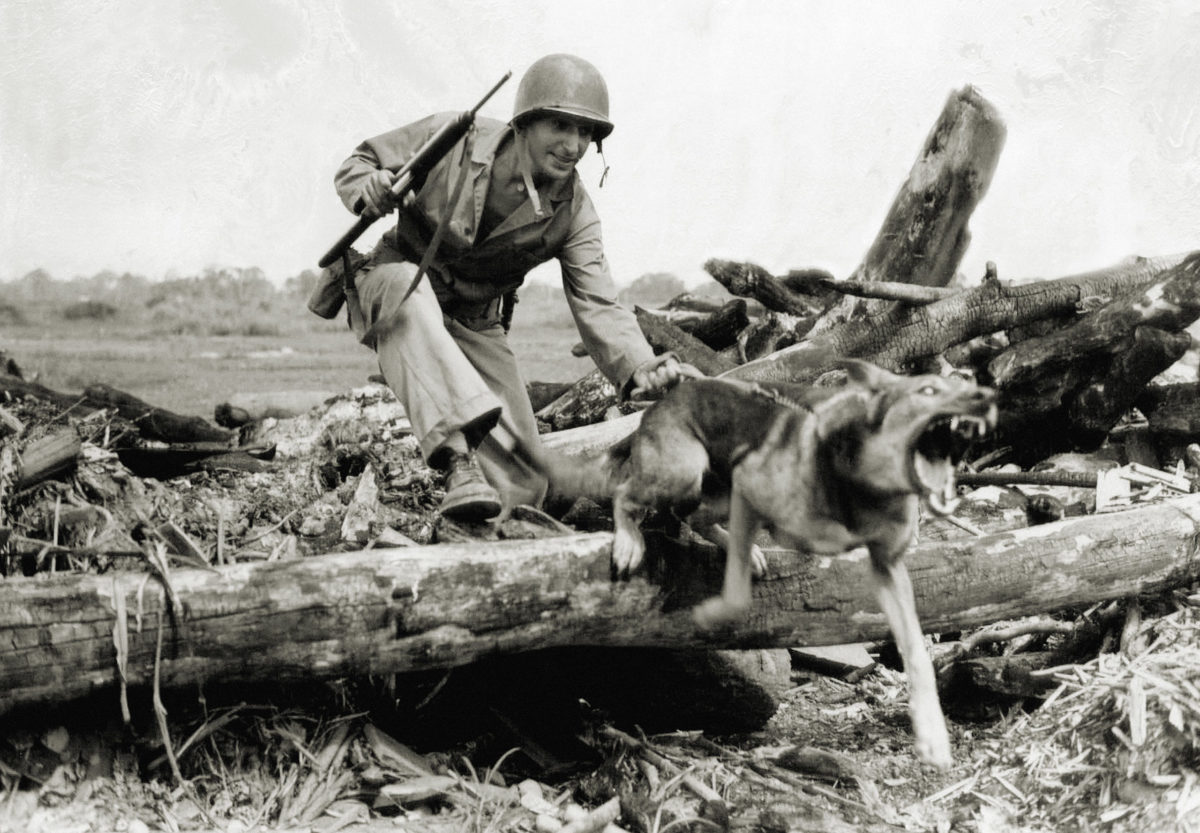Private Raymond Nosaka raced to the base of a live oak tree in the mosquito- and alligator-infested interior of Cat Island, nine miles offshore from Gulfport, Mississippi, in the Gulf of Mexico. The humidity was stifling, even in December. Nosaka began to climb the oak, the hockey pads he wore making the ascent even more difficult. He steadied himself on a branch 10 feet off the ground and caught his breath. Minutes later, he could hear a pack of dogs crashing through palmettos and marsh grass, hunting him.
A German shepherd reached the oak first, followed closely by a boxer and some kind of mutt. As Nosaka looked down at the snarling and barking dogs, he found it hard to imagine that they, and the four or five dozen other canines kenneled on the tiny island, had been household pets just a year earlier. Like him, they had been volunteered for secret and experimental training.
Taking a deep breath, Nosaka fired a pistol into the air and jumped to the ground. In an instant, all three dogs were on him, sinking their teeth into the leather and cotton that covered most of his body.
During World War II, nearly 20,000 U.S. families donated their canine pets for military service through the Dogs for Defense program, the brainchild of a group of dog-loving civilians. The U.S. Army’s Quartermaster Corps trained most as guards, scouts, messengers, and casualty locaters. It wasn’t unprecedented: The German military had been using dogs in tactical capacities since the late 19th century and other European forces followed suit in World War I. When the United States entered World War II, its military had fewer than 100 dogs, used primarily to pull sleds in the Arctic. In January 1942, prominent New Jersey canine expert and poodle breeder Arlene Erlanger joined with Professional Handlers’ Association head Len Brumby and New York Sun reporter Arthur Kilbon to organize what they called Dogs for Defense. They intended to recruit canines the military could use to patrol Atlantic beaches, key industrial facilities, and other places ripe for saboteurs. Americans responded enthusiastically, donating healthy dogs from a list of 30-some breeds that were deemed trainable, adaptable to military working conditions, and appropriately sized—ideally around 50 pounds. Some parted with their pets out of patriotism, while others could no longer care for them due to deployments, increased work hours, or economic hardship.
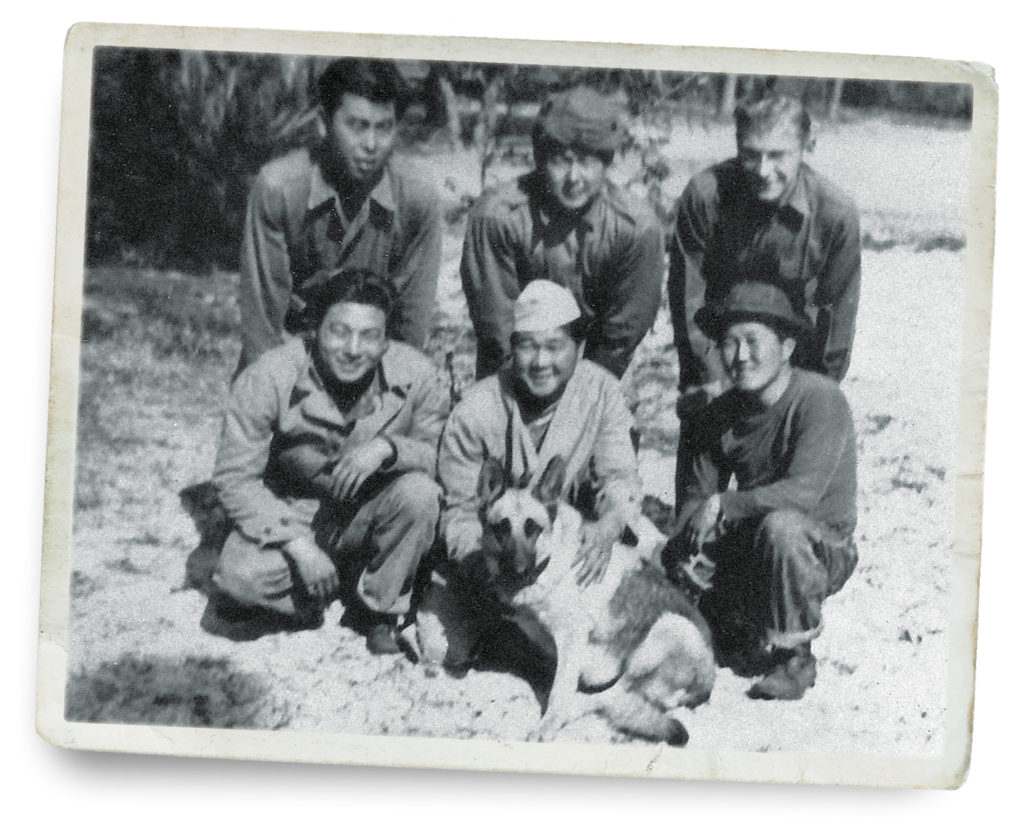
By July 1942, Dogs for Defense’s first hundred canine “volunteers” had proven their utility as sentries. The Secretary of War then expanded the “K-9 Corps” to include scout and messenger dogs and assigned training responsibilities to the Remount branch of the Quartermaster Corps, which traditionally provided trained horses for army units. Dogs for Defense, now backed by the American Kennel Club, continued to lead recruitment, while Erlanger drafted the army’s first formal dog-training manual. By the end of 1942, the Quartermaster Corps had dog and handler training facilities in Front Royal, Virginia, and Fort Robinson, Nebraska, and had plans to open others at San Carlos, California, and Camp Rimini, Montana. Graduates were assigned to U.S. Army, Coast Guard, or Marine Corps units.
In June 1942, a Swiss expatriate dog trainer in New Mexico named William A. Prestre wrote to the War Department suggesting another war-time opportunity for canines. Prestre believed dogs could be taught to sniff out and attack Japanese servicemen based on their distinct smell. Although the dog trainer had no scientific basis for his theory, the War Department was intrigued enough by the possibility to finance an attack dog experiment under the Army Ground Forces, rather than the Quartermaster Corps. Secrecy was paramount—Americans might hesitate to donate their precious pets for such violent duty.
Prestre, who would be paid as an army captain, toured the Quartermaster Corps’ Front Royal facility in September and initially dismissed the line-up of volunteer dogs there. He asked the army to launch its own selective breeding program and field only animals between the ages of one-and-a-half and two years. The army refused. With U.S. ground forces already entangled with the Japanese on Guadalcanal, there wasn’t time. Prestre needed to work quickly.
To train his dogs, Prestre required ethnic Japanese targets. The army wouldn’t use Japanese prisoners, as Japan could exact reprisals on its American prisoners should word of the program leak. Instead, the army drafted a small contingent of men from its 100th Infantry Battalion (Separate), one of its two segregated Japanese American units. (The other was the 442nd Regimental Combat Team.) At the time, all soldiers in the 100th were second-generation Japanese immigrants, or “Nisei,” and former Hawaii National Guardsmen.
Honolulu-born Nosaka was training at Camp McCoy, Wisconsin, when he and 26 others in the 100th’s B Company, Third Platoon, received orders for a secret mission somewhere in the South. On November 3, 1942, they boarded a plane for an unknown destination. Arriving in Gulfport, Mississippi, they were ferried into the dark Gulf of Mexico at nightfall, lest any daytime onlookers question the presence of a boatful of ethnic Japanese men.
The army leased uninhabited and privately owned Cat Island as an isolated training ground in an environment that somewhat resembled a Pacific combat setting. First explored by the Spanish in the 16th century and named by the French in 1699 for its menacing population of raccoons, or chats sauvages, the 2,350-acre island was shaped like a “T,” with the stem running east-west for five miles and the top running north-south for three. The War Dog Reception and Training Center shared the island with a bombing range and a practice landing area that was used by Naval Construction Battalions.
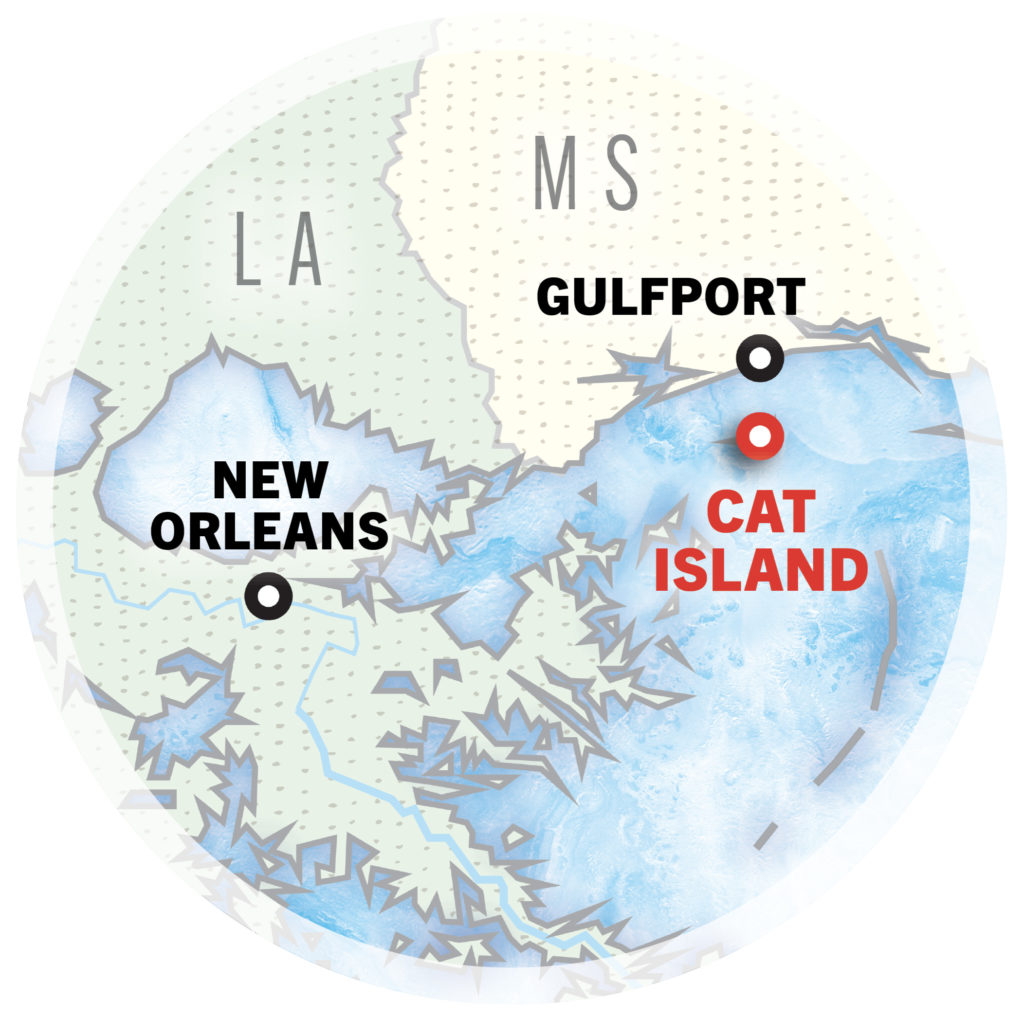
The 25 enlisted Nisei and two officers debarked that first night on neighboring Ship Island, eight miles due east of Cat Island, which the Coast Guard used for anti-submarine patrols and the army for recreational facilities. Here the men were housed in barracks near Fort Massachusetts, a 19th-century brick fortification used by both sides during the U.S. Civil War. Two weeks into their stay, the soldiers were finally informed that they would continue to bunk on Ship Island and ferry daily to Cat Island to train war dogs.
“They said to ‘train the dogs,’ but we called it ‘dog bait,’” Nosaka remembered. “We were the bait.”
The Japanese American soldiers arrived on Cat Island mid-morning each day. There they joined about 30 personnel stationed on the island and 50 to 60 dogs housed in neat rows of wooden kennels elevated above the white sand. Each soldier was issued a helmet, padded clothing, and slabs of raw horse meat. The first phase of the program was to train the dogs to find the Nisei in foxholes or trees in the brackish marsh that made up half of the island. The men honed their climbing skills quickly. Although the raccoons were long gone, a slip could easily land a soldier within reach of a hungry alligator. When a dog found a Nisei, the soldier would fire a pistol into the air, pretend to fall dead, and toss the dog the meat as a reward.
Prestre, who was rarely seen by the Nisei, believed dogs would work best in packs and that the constant presence of a human handler would impede their work. The results quickly created doubts about his methods. Once released, a pack of dogs typically separated, and few proved able to find their bait without human intervention. Those that did were clearly lured by the horse meat. The army was concerned, and a few weeks into the program it sent one of its own dog trainers, Master Sergeant John Pierce, to Cat Island. His assignment was to train dogs to alert human handlers when an enemy was present and attack only on command. Pierce’s training proved more successful than Prestre’s and it reinforced the sense that dogs worked best individually or in pairs, and always under a handler.
Still confident in his approach, Prestre moved from scout to attack training. He had dogs released into the marsh to find and “kill” the Nisei. The soldiers acting as bait now submitted themselves to the dogs’ jaws, sometimes wrapping meat around their necks to encourage bites to the jugular vein. The protective padding helped, but most of the men left Cat Island bearing scars. Nosaka had to visit the small dispensary multiple times to receive treatment for bites to his legs and feet.
As the dogs grew more familiar with the Nisei, they became less willing to attack and would often just grab the horse meat and run. Prestre resorted to brutal methods that canine-loving soldiers like Nosaka found despicable. The trainer had dogs tethered and the Japanese Americans were ordered to whip and beat them until they drew blood. Then the padded men would back up 10 paces and the dogs were released to exact a vicious reprisal. “Oh, I feel so bad,” Nosaka recalled years later as he remembered the brutality.
Despite the unique hardships of their duty, the Japanese Americans on Cat Island enjoyed four-hour workdays, plenty of beach time, and fresh seafood. One December evening an alarmed shrimper alerted authorities that two Japanese men had rowed to his boat near Ship Island and claimed to be American soldiers seeking shrimp for their Christmas dinner. On New Year’s Day 1943, the men received a pass to New Orleans to watch the University of Tennessee Volunteers defeat the University of Tulsa by a touchdown, 14-7, in the Sugar Bowl.
In mid-January, Army Ground Forces leadership visited Cat Island for a review of the dogs’ readiness for war. The results were dismal. Prestre had to lead the animals to the Japanese American soldiers and very few were willing to attack on command. Colonel Ridgely Gaither dismissed the demonstration as “somewhat of a vaudeville animal act.” On February 2 the army cancelled Prestre’s program and relieved him of his duties. The Swiss expat was livid. He issued vague threats to cause trouble if the program were not reinstated, which landed him on an FBI list of potentially dangerous subversives. Prestre promptly disappeared from the public record.
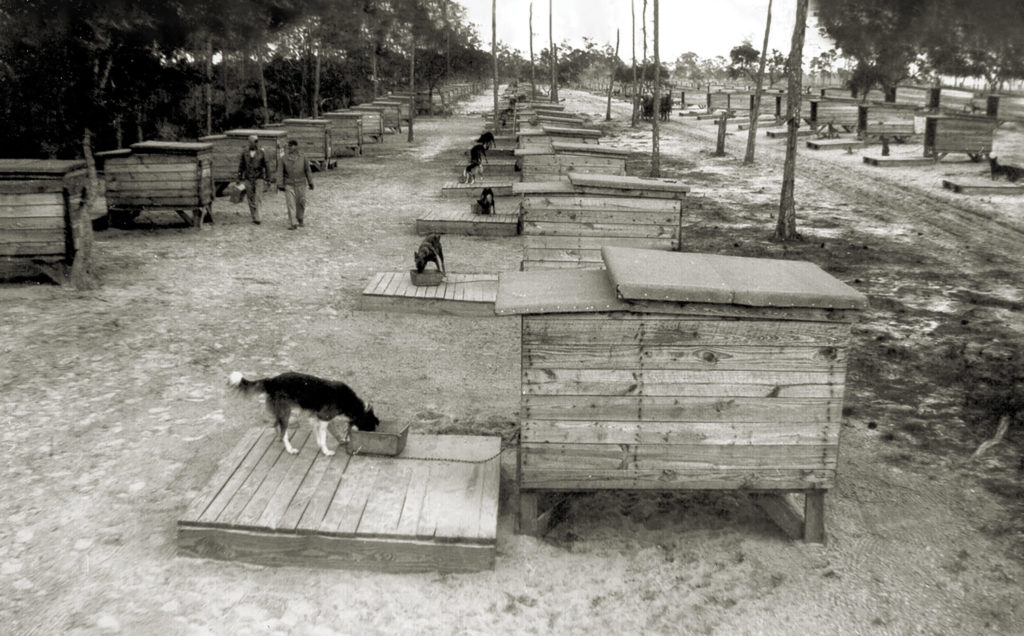
The trainer’s belief that dogs could differentiate ancestral heritage by smell proved unfounded—human scent is determined primarily by diet and the men of the 100th ate like the average U.S. soldier, apart from the extra shellfish. The army, however, was not willing to give up and continued to explore the utility of exposing dogs to people of Japanese heritage. The original group of Nisei soldiers remained on Cat Island several weeks after Prestre’s departure, presumably training under Pierce. Nosaka was one of the last to transition back to the 100th Battalion, returning on March 21 to train for the pending invasion of Italy in September. The 100th would become the most decorated U.S. military unit of the war for its size and length of service. Several of the men who served on Cat Island would be wounded or killed in action.
Prestre’s experiment ended the Army Ground Forces’ dog training, but the K-9 Corps continued to grow. The Quartermaster Corps assumed management of the Cat Island center and expanded facilities to accommodate the training of 400 dogs and their handlers for a variety of tactical duties. For instructors, the army recruited civilian experts—from esteemed bird hunters to guide-dog trainers—then scoured its ranks for anyone with useful experience.
Robert Coates was nearing the end of basic training with the 94th Infantry Division in May 1943 when the army noticed he had expressed an interest in dogs on his induction paperwork. He received an invite to join the dog training program. Coates, whose family had volunteered its collie for Dogs for Defense, accepted. He reached Cat Island on June 15 as a sergeant and moved into the island’s standard lodging: a 16-foot-square, five-man hut made half of plywood, half of mesh screen, and topped with a canvas roof. Although Coates served on Cat Island months after the “dog bait” of the 100th Infantry Battalion departed, he and other trainers recalled working with a handful of Japanese American soldiers, likely from the 442nd Regimental Combat Team, who would hide in the brush so the dogs could find them.
Coates trained several dogs, his first a smart and friendly German shepherd named Champ. As a scout trainee, Champ learned to stop, stiffen his body and tail, raise his hackles, and prick his ears when he detected an unfamiliar human. Coates’ second dog was Sis, part of a casualty detection training program. Sis learned to locate humans lying on the ground and alert her handler. Other dogs received training to identify manmade disturbances in Cat Island’s sand that might indicate the presence of a non-metallic German mine that was undetectable by traditional methods.
The island also provided home to a program that trained dogs to run messages through difficult terrain using leather pouches attached to their collars. For practice, the dogs were frequently dispatched to deliver notes between the main camp and the various training sites across the island. Toward the end of 1943, a contingent of the 828th Signal Pigeon Replacement Company arrived on the island to test whether dogs could effectively carry messenger pigeons on their backs and bring them to isolated outposts.
By 1944, the army had fine-tuned the list of breeds that were most useful for its purposes. They included German shepherds, Doberman pinschers, Belgian sheepdogs, collies, giant schnauzers, Siberian huskies, malamutes, and Eskimo dogs. Not all dogs were eager to work or disciplined enough for their assigned tasks. More than one finely bred animal was dismissed from the K-9 Corps for chasing Cat Island’s native pigs. Others were more helpful with the wildlife. Johnnie Johnson, an army trainer from Tidewater, Virginia, was crawling through the marsh with an exceptional scout, a springer spaniel named Susie, on a night exercise when the dog signaled him to stop 10 feet shy of a deadly coral snake. Despite her apparent abilities, Susie mysteriously failed her test for overseas scout duty and the Midwestern kennel that had donated her gave Johnson permission to keep her as a pet. He later admitted that he had failed Susie intentionally because he couldn’t bear to part with her. The dog lived to age 17.
Although the Quartermaster Corps continued training elsewhere, the Cat Island War Dog Reception and Training Center closed in July 1944. The island returned to private ownership after the war. In 2002, the National Park Service acquired nearly 2,000 acres for inclusion in the Gulf Islands National Seashore.
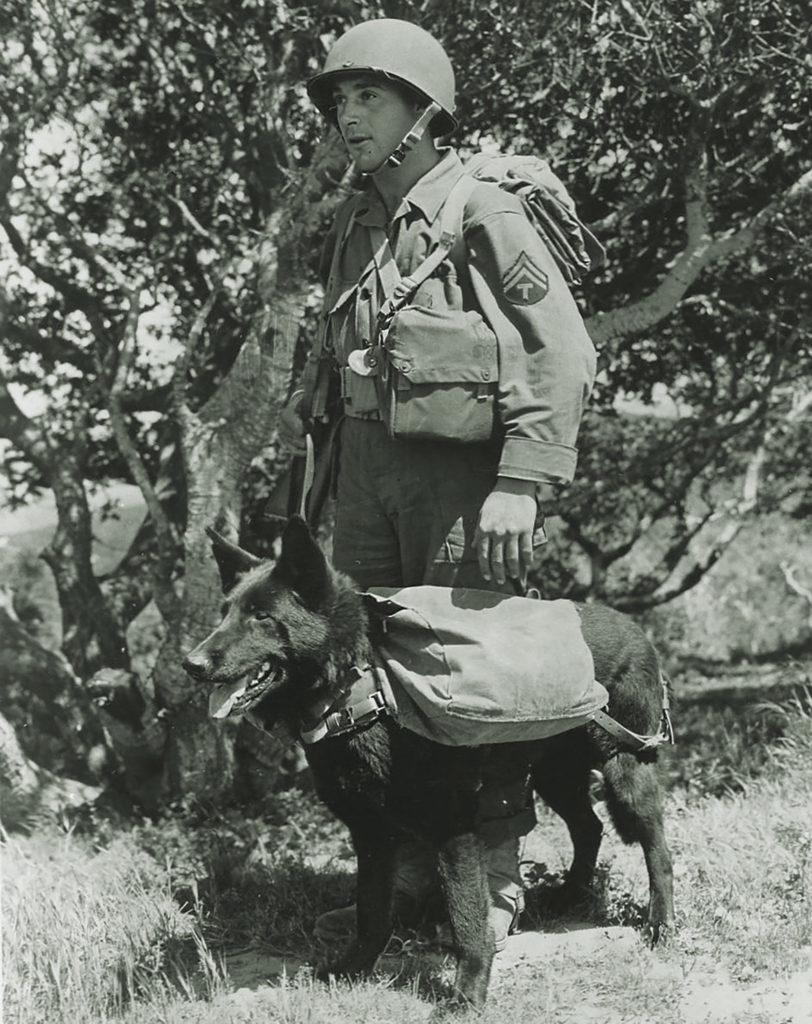
From 1942 through March 1945, Dogs for Defense recruited more than 19,000 dogs, approximately 10,400 of which completed training and were deemed suitable to serve with the U.S. Army, Marines, or Coast Guard. At least 1,000 other dogs were donated by breeders, smuggled into the military by their serving owners, or adopted by units that befriended them in the course of duty. About 1,900 dogs saw service overseas, among them members of 15 Quartermaster Corps-trained dog platoons. The scouts in these platoons, seven of which served in Europe and eight in the Pacific, received credit for dramatically reducing enemy ambushes.
At the end of the war, the Quartermaster Corps eased the war dogs’ transition back to civilian life. Coates, who had attended Officer Candidate School after leaving Cat Island, supervised German prisoners in a dog retraining program at Front Royal. Most Dogs for Defense returned to their original owners or were adopted by their wartime handlers. The army received 15,000 applications for the remaining 3,000 dogs that were available for purchase as war surplus. Of all dogs placed with new owners, only four were returned as unsuitable for civilian life.
Working canines had proven their worth. Training responsibility transitioned from the Quartermaster Corps to Army Field Forces in 1948. About 1,500 dogs served in the Korean War, primarily as sentries. Four thousand deployed to Vietnam, where 281 were killed in action. In the Persian Gulf and 21st-century conflicts, dogs have added search and rescue to their military roles, along with drug and explosives detection. Dog training responsibilities today belong to the 341st Training Squadron at Joint Base San Antonio, Texas.
The canines’ most valuable contribution in war has likely been companionship. Their instinctive loyalty and compassion have helped soldiers cope with the hardships of combat and its aftermath. Nosaka, who agonized over being forced to abuse the training dogs on Cat Island, owed his life to the kindness of a stray he encountered on the 100th Battalion’s long and bloody push toward Rome. During one cold evening in November 1943 in the hills near Italy’s Santa Maria Oliveto, an artillery shell badly injured Nosaka’s right thigh. That night, as Nosaka lay wounded, a dog wandered up and slept beside him, keeping Nosaka warm until help arrived in the morning.

